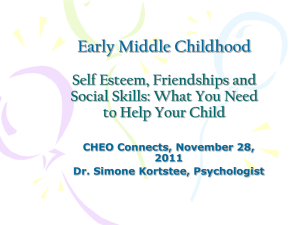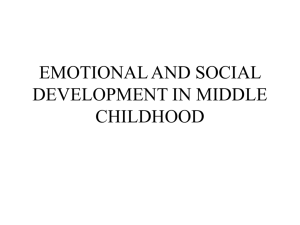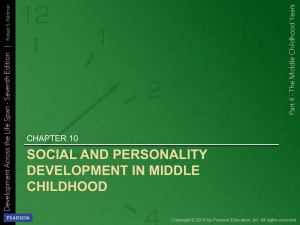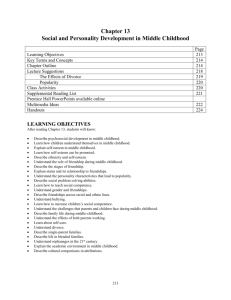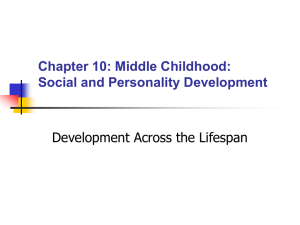Chapter 13
advertisement
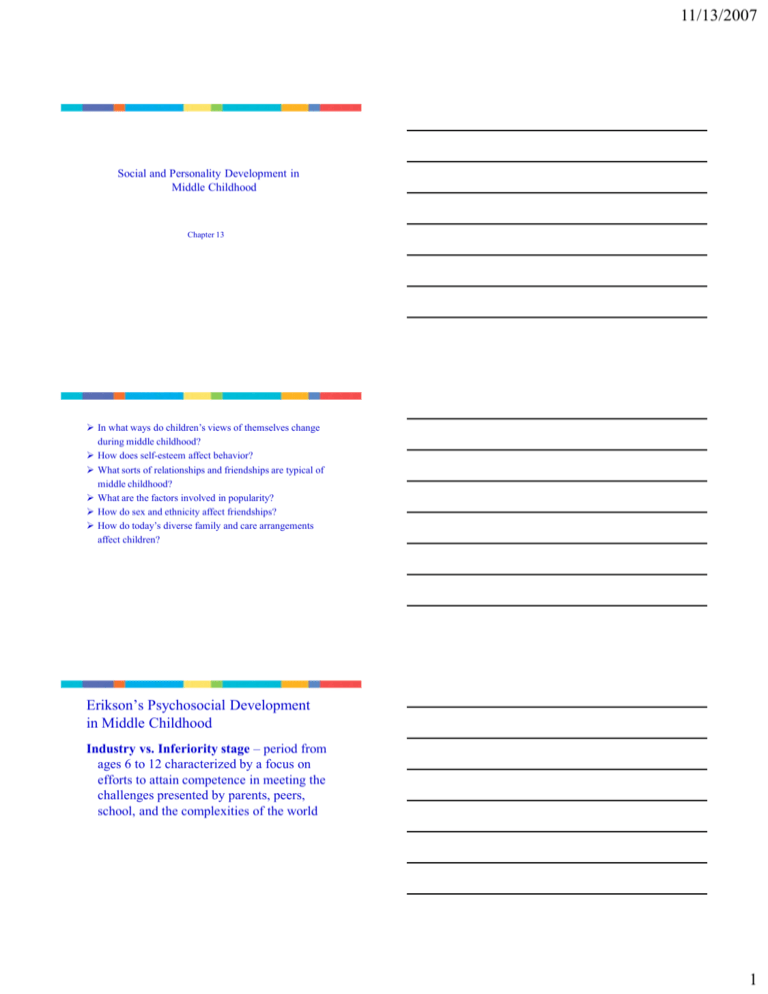
11/13/2007 Social and Personality Development in Middle Childhood Chapter 13 In what ways do children’s views of themselves change during middle childhood? How does self-esteem affect behavior? What sorts of relationships and friendships are typical of middle childhood? What are the factors involved in popularity? How do sex and ethnicity affect friendships? How do today’s diverse family and care arrangements affect children? Erikson’s Psychosocial Development in Middle Childhood Industry vs. Inferiority stage – period from ages 6 to 12 characterized by a focus on efforts to attain competence in meeting the challenges presented by parents, peers, school, and the complexities of the world 1 11/13/2007 Understanding the Self • As children become older, they view themselves in terms of psychological attributes in addition to their physical attributes. • A child’s self-concept becomes divided into personal and academic spheres. Looking Inward: Development of the Self • Self-esteem – an individual’s overall and specific positive and negative self-evaluation • Social comparison – evaluation of one’s own behavior, abilities, expertise, and opinions by comparing them to those of others • If self-esteem is low in middle childhood, the result can be a cycle of failure that grows increasingly difficult to break 2 11/13/2007 A Cycle of Low Self-Esteem Damon’s Research: A Child’s View of Friendship in Middle Childhood Passes Through 3 Phases • Stage 1: Basing Friendship on Others’ Behavior (4 to 7 years) • Stage 2: Basing Friendship on Trust (8 to 10 years) • Stage 3: Basing Friendship on Psychological Closeness (11 to 15 years) What Makes A Child Popular? Status – the relative position of a person ascribed by other members of a group Social competence – the collection of social skills that permit individuals to perform successfully in social settings Social problem solving – the use of strategies for solving social conflicts in ways that are satisfactory both to oneself and to others 3 11/13/2007 Problem-solving Steps Social Problem Find and identify relevant social cues Interpret and evaluate the social cues Determine possible problem-solving responses Evaluate responses and their probable consequences Choose a response Respond Gender and Friendships • Boys are idiots. Girls have cooties. These are views offered by elementary-aged boys and girls. • By middle childhood, “border work” occurs, in which forays into the opposite sex’s territory (often) have romantic overtones. • Dominance hierarchy defines the (fairly rigid) rankings that represent the relative social power of individuals in a group. Bullying Bullying victims are often loners, passive, cry easily, and lack social skills. Bullies – 5% come from abusive homes, tend to watch more violent TV, misbehave more at home and school, may tend to lie their way out of things and show little remorse for victimizing others. 4 11/13/2007 Family Life During Childhood • Co-regulation – joint control of children’s behavior exercised by the parents and the children themselves • Children spend significantly less time with their parents during middle childhood. • Children with both parents working can fare quite well as long as parents are loving and sensitive to their children’s needs • Self-care children (“latch key kid”) let themselves into the home after school and wait alone until a caretaker arrives. How Children Spend Time Divorce Both children and parents may show psychological maladjustment for 6 months to a few years following divorce. Children may experience anxiety, depression, sleep disturbances, or phobias. During early stage of middle childhood, children often blame themselves. By age 10 years, children feel the pressure to choose sides and experience some divided loyalty. In some cases, the divorce produces a more positive effect since the children are no longer subject to the high conflict that existed in the intact relationship. 5 11/13/2007 Blended Families • A blended family is a household consisting of a couple and at least one child from a prior relationship. • Role ambiguity exists in blended households as children become uncertain of their responsibilities and roles. School: The Academic Environment Attributions are people’s explanations for the reasons behind their behavior. Weiner proposed a theory of motivation based on attributions. A person’s attempt to determine the causes of her academic success or failure by considering three basic dimensions: 1. whether the cause is internal (dispositional) or external (situational) 2. whether the cause is stable or unstable 3. whether the cause is controllable or uncontrollable Mother’s Beliefs in Children’s Ability 6


